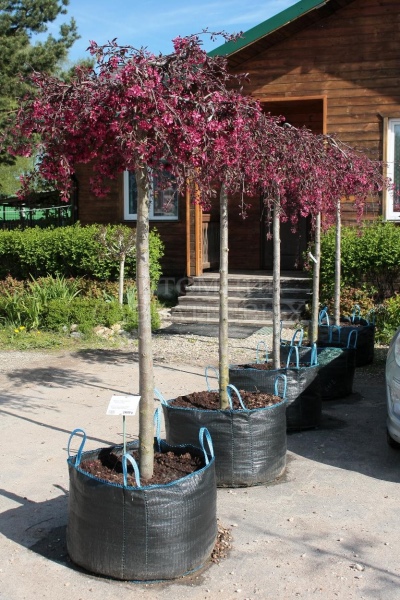
- Fruit size: small
- Removable maturity: September
- Name synonyms: Malus 'Royal Beauty'
- Decorative: Yes
- Height: 3-5 m
- Crown: weeping with a width of 1-2 m, tent-shaped
- Branches: hanging down to the ground
- Escapes: hanging down to the ground
- Flowers: dark pink, up to 3 cm in diameter
- Coloration: dark red, with a purple tint
It is not for nothing that the Royal Beauty apple tree has such a magnificent name. It can be of significant benefit to gardeners. However, it is necessary to deal with all the nuances of its cultivation in order to eliminate mistakes and achieve maximum results.
Breeding history of the variety
The name should not be misleading - this is a culture of purely domestic origin. And it appeared in the middle of the twentieth century. The apple tree of Nedzwiecki was taken as a basis, which has already proven itself well in different places. And the new type initially had, according to the developers' idea, a decorative purpose, which is emphasized by its name. The plant has a synonym - Malus Royal Beauty.
Description of the variety
An attractive feature of the plant is its graceful red foliage. At the same time, a solid aesthetic quality does not interfere with achieving good vegetative indicators. The fruits themselves also add charm to the Royal Beauty. This variety is great for decorating both personal backyards and public spaces.
The crown with a width of 1-2 m at Royal Beauty is formed according to the weeping type. The height of the tree is from 3 to 5 m. The shoots hang down to the ground. The leaves are green, with a purple admixture, when they bloom, they have a bronze-red color, and in the fall they acquire an orange-brown tone. Such an apple tree will bloom profusely.
Features, pros and cons
The negative sides of culture are:
inedible fruit without heat treatment;
weak growth;
severe inhibition of growth with any pruning.
However, these problems are completely counterbalanced:
decent weather resistance of the tree;
minimum requirements for soil quality;
the ability to grow in almost any climate;
lack of complex sophisticated care.
Normally, the annual growth is 20-25 cm. In mature trees, the crown acquires an umbrella-like appearance. The diameter of yellow flowers sometimes reaches 5 cm (in other sources they write about 3 cm). Purple or dark cherry-colored buds are characteristic. The fruits will stay on the branches for a long time.
Ripening and fruiting
The first buds on Royal Beauty can be seen already in the first or second year of cultivation. However, it is still a barren flower. Real fruiting comes at 3, sometimes 4 years. Bunches of apples are not typical for this culture, it gives single fruits. Already at an early stage of fruiting, collecting 1-1.5 kg of fruit does not surprise anyone.
Yield
This characteristic is not described anywhere. Such a moment is connected with the fact that the plant has no culinary value. But there are really a lot of apples - they always mention that the branches of Royal Beauty are strewn with small fruits.
Fruits and their taste
They are typically dark red in color. The fruit itself has an oblong shape, similar to an elongated cone. Apples are small in size. Their cross section does not exceed 1.5 cm. Eating is impossible due to the presence of substances unsuitable for humans, therefore the taste is not classified or described.

Growing features
Royal Beauty requires fresh soils with good moisture levels. Dense or salty soil is unsuitable. Slightly acidic and neutral loams and sandy loams are preferred. The plant is photophilous, tolerates (but just tolerates) partial shade. The gap between trees should be 2.5 m, and the row spacing should be 4 m.
If groundwater is closer than 2 m to the surface, the apple tree almost inevitably dies. Excess moisture on the surface is also destructive. The planting hole should be twice the size of the root ball. Bad soil is improved using a mixture of:
3 parts of humus;
1 piece of leafy land;
2 parts sand.
In the year of planting, Royal Beauty must be watered actively. In subsequent seasons, watering should be increased only against the background of drought. To make the water evaporate more slowly, the trunks are mulched with pine bark or wood chips. Deepening of the root collar is unacceptable. Sensitivity to pruning cannot be considered a serious drawback, because even without it, the apple tree looks decorative; only occasionally are careful sanitary and anti-aging pruning done.




Frost resistance
Royal Beauty is a winter-hardy culture. It hibernates calmly at temperatures down to -30 degrees. Therefore, the usual winter in most of the middle zone will endure quite calmly. However, during the harsh season, additional shelter is still needed. It will also be needed in Western Siberia, the Urals, and other cold regions.


The apple tree is a popular fruit crop among gardeners. It can be found in many summer cottages. But at the same time, such trees are often affected by various diseases. It is very important to recognize the disease in time and carry out the necessary procedures for a speedy recovery. Otherwise, the fruits will be spoiled, and the tree itself may die altogether.

Review overview
They note:
indeed, a spectacular view, especially in spring;
minimum whimsical variety;
abundant fruiting;
maintaining visual appeal in any season of the year.











































































